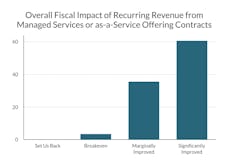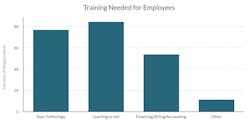This article originally appeared in the February 2022 issue of Security Business magazine. When sharing, don’t forget to mention Security Business magazine on LinkedIn and @SecBusinessMag on Twitter.
The conversation in the security integration market around service revenue is getting old. There’s no other way to say it. It is difficult for a security integrator to attend an industry conference, watch a webinar or read an article in an industry trade publication without stumbling onto a business case for shifting from too much reliance on product- and project-based revenue models to more of a recurring, service-oriented program.
When the National Systems Contractors Association (NSCA) and PSA Security Network of integrators decided to work together on a research project around recurring revenue, we sought to evolve the conversation. Instead of making a case for why integrators should shift to service, we focused on the how.
Both organizations identified integration companies that have demonstrated relative success selling services, and then we conducted a small, targeted survey to uncover commonalities among successful service integrators.
About two thirds of this focus group represent companies with less than $50 million in gross revenue, while the other third represents the larger companies. They are diverse in that some offer as-a-service, some managed services, and others simply service contracts. The group includes integrators in the security, AV, life safety and IT markets.
7 Key Takeaways
The focus group reflected in “Anatomy of a Successful MSP” (available at www.nsca.org/industry-research) might not provide a step-by-step blueprint toward building a recurring revenue program; however, it is certainly a step in the right direction.
Here are seven keys the we discovered from the research (be sure to download the report for further insights):
1. It takes time. The integrators did not necessarily become successful right away; in fact, the largest percentageVery few demonstrate success in the first couple of years. “In order to really get started with hosted access control and video managed services, we had to make at least a two-year commitment to change the path of what we were going to do,” explains respondent Trevor Stewart, president of Security Control Integrators.
2. It takes research. Virtually every company in the focus group – 96% – say they spent significant time researching pricing, structure and offerings.
3. It takes training. A critical building block to a successful service integration company seems to be training. Much of the training was focused on sales – including how to sell managed services or as-a-service vs. traditional projects. More than half of the focus group also trained their accounting departments on how to handle the different cadence of financing and billing.4. It does not necessarily require a lot of new talent. Perhaps the aforementioned training has something to do with the fact that a majority of respondents did not need to hire new employees to implement a service program.
5. It takes a nimble sales approach. It goes without saying that, if your sales team cannot sell your service offerings, you are not going to be successful. “There is a risk of ‘reluctance’ on the part of sales teams to embrace the service-based program,” says Jim DeStefano, SVP at Unlimited Technology.
Respondents indicate that structuring incentive programs is necessary. About two thirds created different sales incentive programs for service-based sales; however, it does not appear that a separate sales team is“We’ve been fortunate that most of our employees and most of our salespeople have embraced managed services,” DeStefano adds.
6. It takes a village. Most integration companies cannot make the transition from project- to service-based offerings without third-party help. About two-thirds worked with a company to create or deliver monthly financing. Companies also tended to lean on their ERP or CRM software providers or turned to new ones to create customized solutions.7. It takes constant reevaluation. For most of the respondents, “set it and forget it” does not seem to work. For one thing, the ongoing needs of customers evolve; therefore, an integrator’s service offerings need to adapt.
“M3T Corporation is in ‘version two’ of our managed services offerings,” President John Maffey explains, adding that it is a result of the company listening to customers, recognizing areas in which their program can improve, and pivoting.
Tom LeBlanc is Executive Director of National Systems Contractors Association (NSCA). Learn more at http://NSCA.org.
About the Author
Tom LeBlanc
Tom LeBlanc is the Executive Director of the National Systems Contractors Association (NSCA). Learn more at www.nsca.org.




